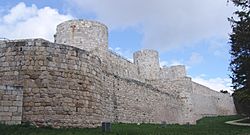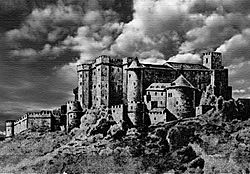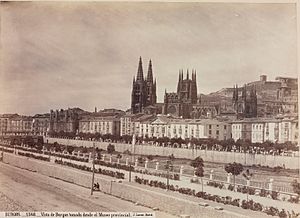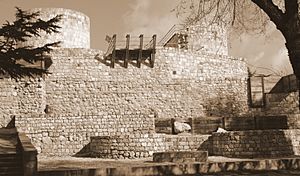Castle of Burgos facts for kids
Quick facts for kids Castillo de Burgos |
|
|---|---|
| Burgos in Spain | |

The ruins of the Castle of Burgos in 2008.
|
|
| Type | Castle |
The Castle of Burgos was a mighty fortress and royal palace, or alcázar, in the city of Burgos, Spain. It sat on a hill about 75 meters above the city, offering amazing views. For centuries, it was a home for the kings and queens of Castile.
The castle's story began long ago, possibly with the Romans and Visigoths. It grew into a huge and important fortress over many years. However, its fate changed during a war in 1813. French soldiers who had been using the castle decided to destroy it with explosives as they retreated. The massive explosion left the castle in ruins, which is how it remains today.
Contents
The Castle's Long History
The First People on the Hill
Long before the castle was built, people lived on the hill where it stands. Archaeologists have found clues of human life from thousands of years ago. They discovered items from the Beaker culture and the Iron Age. The oldest settlement found on the hill dates back to around 2000 B.C.
Building a Mighty Fortress
The first fortress was likely built around the year 865. About twenty years later, King Alfonso III of Asturias ordered Count Diego Rodríguez Porcelos to make Burgos stronger. This was to protect the area from invaders.
As the city of Burgos grew, it needed a powerful castle. Over time, builders made it larger and stronger. Travelers who saw it wrote about how safe and secure it felt. King Alfonso VIII of Castile hired expert builders who gave the castle a beautiful Mudéjar style, which blended Christian and Islamic art. Later, King Henry IV of Castile turned it into a fancy palace with grand halls, private rooms, and a chapel.
The castle was so important that people said:
"The kings of Castile, having that fortress, has title to the kingdom... because it is head of Castile and chamber of the kings."
Famous Sieges at the Castle
A siege is when an army surrounds a castle to try and capture it. The Castle of Burgos faced two major sieges.
The War of the Castilian Succession
The first big siege happened in 1474. It was part of a war to decide who would rule Castile. The army of Ferdinand II of Aragon and Isabella I of Castile surrounded the castle. They tried to cut off the water supply by digging tunnels to find the castle's well. The fighting was intense and lasted for over a year, until the castle finally surrendered in 1476.
The Peninsular War
The castle was not attacked again for over 300 years. In 1812, during the Peninsular War, a British and Allied army led by the Duke of Wellington besieged the castle. The French army was defending it. Wellington's army had trouble getting supplies, and French reinforcements were on their way. After several failed attacks, Wellington had to give up the siege and retreat.
Famous Prisoners
The Castle of Burgos was also used as a high-security prison for important people. King García II of Galicia and King Alfonso VI of León and Castile were both held prisoner here. Another famous prisoner was Tomás de Gournay, who was involved in the death of King Edward II of England.
In 1277, Prince Frederick of Castile was executed in the castle on the orders of his own brother, King Alfonso X of Castile.
From Fortress to Factory
As military technology changed, the castle became less important for defense. Spain's wars were being fought in other countries. In the 1500s, a part of the castle was turned into Spain's first training school for artillerymen. It also became a factory that produced a large amount of gunpowder every day.
The Castle's Destruction
A fire in 1739 damaged much of the castle's interior. But the final blow came during the Peninsular War. French soldiers had taken over the castle and made its defenses stronger.
In 1813, the Allied army under the Duke of Wellington was advancing quickly. The French commander decided to abandon the castle. To prevent the Allies from using it, he ordered it to be blown up with explosives. The demolition was done in such a hurry that the last group of French soldiers didn't have time to escape. Over 200 of them died in the explosion.
The blast was so powerful that it shook the entire city of Burgos. It destroyed the nearby Church of Santa María La Blanca and shattered most of the windows in the famous Burgos Cathedral.
The Castle in Modern Times
After its destruction, the castle was used a few more times during later wars, but it was never rebuilt.
In the 19th century, a tower was built on the ruins as part of a semaphore line. This was an old-fashioned communication system that used towers with movable arms to send messages over long distances, like a telegraph but with signals you could see.
Starting in 1985, archaeologists began to study the ruins carefully. They made an amazing discovery: a deep well with a spiral staircase going down into the earth. A team of cave explorers went down 61 meters into the well. They were impressed by the skill it took to build it so long ago.
Visiting the Castle Today
Today, the Castle of Burgos is a park and a museum. Visitors can walk among the ruins and imagine what the great fortress was once like. You can explore what's left of the walls, gates, and towers.
The main attraction is the underground well, sometimes called Cueva del Moro (Cave of the Moor). You can see the deep well shaft and the tunnels that were dug to supply the castle with water. It is a great example of medieval engineering.
The castle grounds are now a peaceful place with paths named after poets. It's a popular spot for locals and tourists to learn about the history of Burgos.
See also
 In Spanish: Castillo de Burgos para niños
In Spanish: Castillo de Burgos para niños
- List of missing landmarks in Spain





